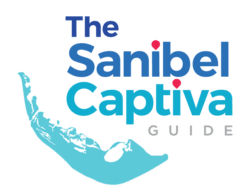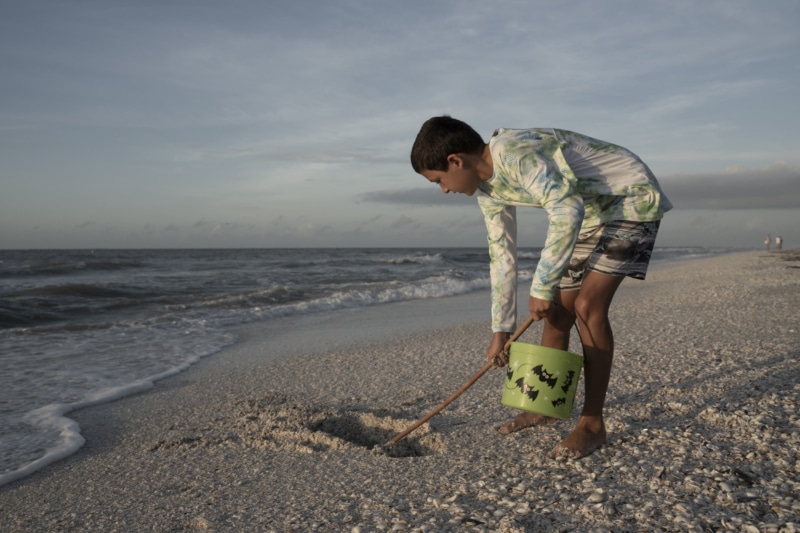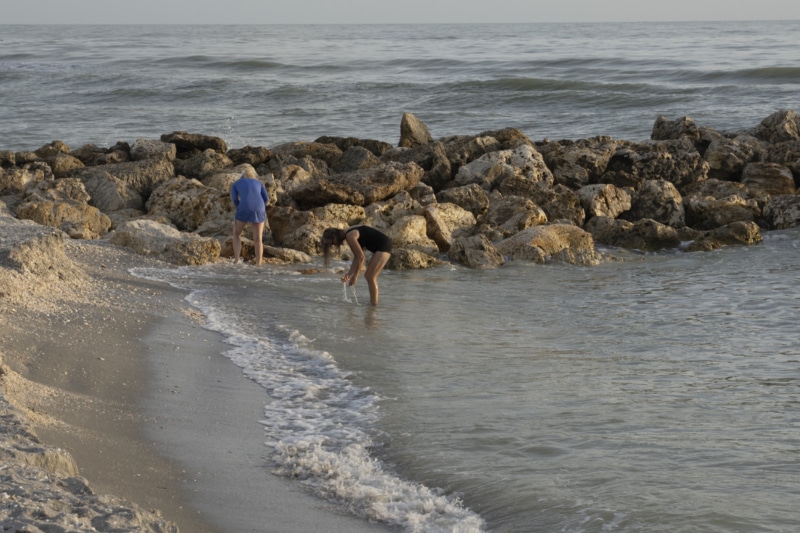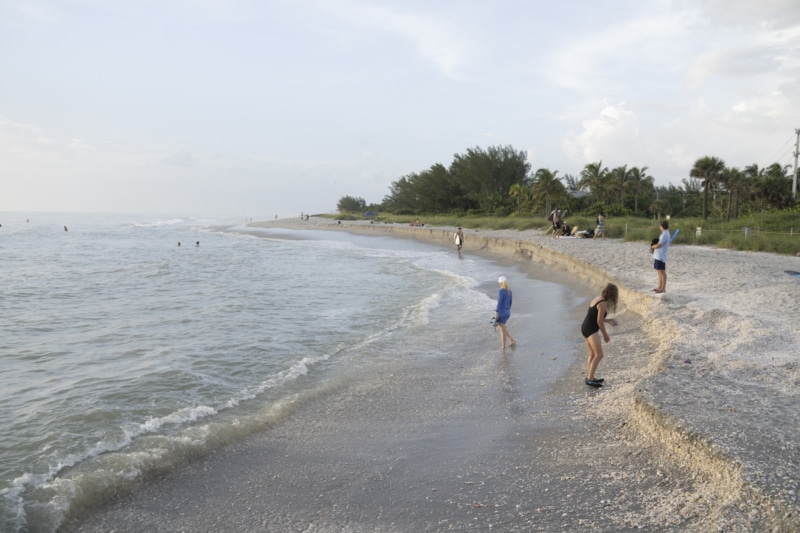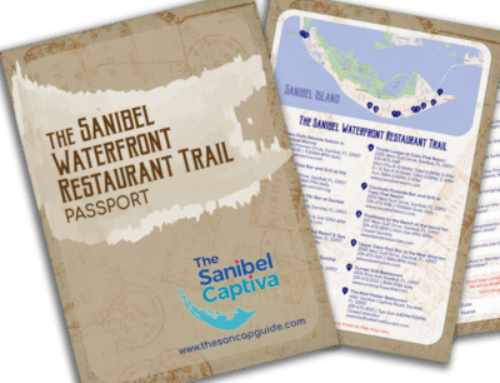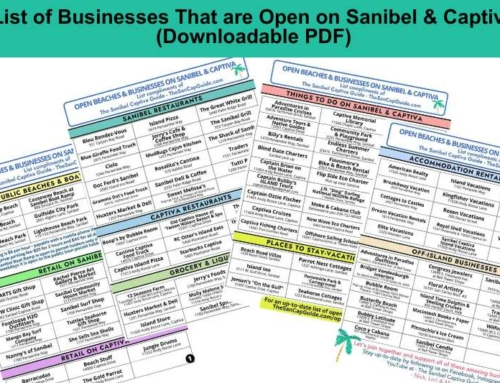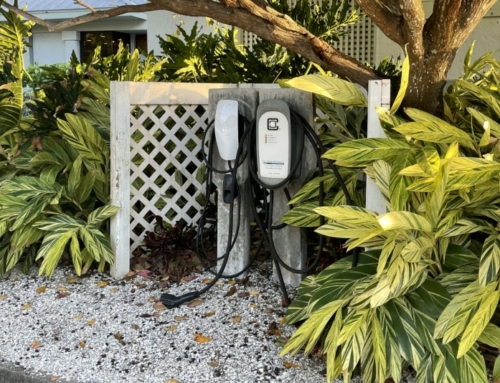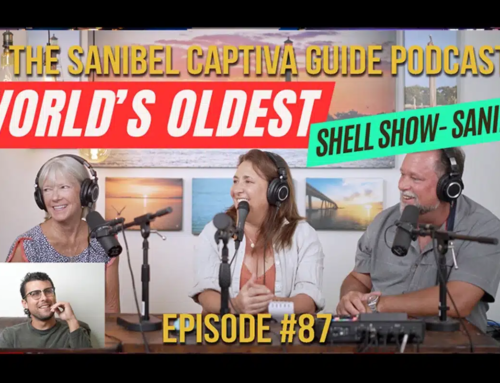All About Shelling On Sanibel Island
This guide will tell you all about shelling on Sanibel Island and Captiva Island. Sanibel and Captiva are famous for having the best beaches for shelling.
The islands are world-class shelling destinations with over 250 types of shells to explore. Thousands of visitors come every year hoping to find the best shells: anything from a common Traverse Ark to the prized Junonia shell. Be on the lookout for the Sanibel Six!
Sanibel Island is also home to The Bailey-Matthews National Shell Museum!
Discover The Best Beaches To Find Shells

There are 9 beautiful beaches to be explored on both Sanibel and Captiva Island, all are often amazing for shelling and of course views! Here are a few of our favorite spots, for the best shelling.
Bowman’s Beach
This gorgeous stretch of white sands and turquoise water is a treasure trove for beachcombers searching for shells! Low or high tide this beach has some of the best shelling on Sanibel Island.
Lighthouse Beach
Lighthouse Park is a good spot for shelling, not only can you find Sanibel’s iconic lighthouse standing tall on this beach, but there are also shells galore!
There are many shells scattered all along the shore. Some frequent finds are Whelks and Cockles. You may even find the rare Junonia here!
Blind Pass Beach
The unique thing about this beautiful beach is the added bonus of shells coming in from the gulf side and bayside!
When wading in these blue waters look out for live Sand Dollars at your feet (remember NO live shelling!).
Why is Shelling On Sanibel Island So Good?

The island of Sanibel is the shelling capital of the world and for good reason!
It is clear that southwest Florida is home to some of the best shelling beaches in North America! The beaches of Sanibel Island have such a variety of shells I can’t think of a better place to be!
Sanibel Island is surrounded by an underwater shelf, which has a gentle slope that gradually runs for miles.
The island’s unusual east-west facing orientation along the coast of Florida creates a perfect dustpan for shells to be pulled in by currents in the Gulf of Mexico.
This abundance of tiny treasures has given Sanibel Island its claim to fame. Wading in the waters stunning shells may be washed up against your toes.
While shelling on Sanibel many visitors are known to assume the position of the ‘Sanibel Stoop’ as they bend at the waist looking for shells along sandy stretches. If you are on Captiva it’s called the ‘Captiva Crouch”!
Type of Shells Found On Sanibel Island
Species of shells come in two categories:
Bivalves, which have two hinged sides that clamp together to enclose the species; and gastropods, which consist of a single, curled shell with an enclosed chamber.
Some common examples of bivalves include Scallops, Clams, Cockles, Coquinas, and Lion’s Paws.
Gastropods, have a muscular foot at the bottom and usually both a distinct head bearing sense organs and a spiral shell into which the body can be withdrawn.
Some common examples of gastropods include many varieties of Conch, Murex, Olives, and Whelks.
There is a wide variety of both types of shells found along Sanibel’s stunning shoreline!
When shelling on Sanibel beaches be sure to keep your eyes peeled for these specific treasures. Sanibel has some of the best places to help grow your shell collections!

CONCH SHELL
This type of shell houses animals in the snail family. This species comes in all shapes, colors and sizes, and their shell is usually conical, spiral and pointed at both ends with an opening along the side.
Common examples include the Horse Conch, with a light tan or brown spiral, bumpy body measuring up to about 20 inches. Fun fact, the Horse Conch is the state shell of Florida!
The commonly found Florida Fighting Conch, measuring up to about 4 ½ inches with a brownish body with about seven tapered spiny swirls coming to a pointy top
The Crown Conch measures up to about 5 ½ inches with a brownish or grayish swirl patterned body with rows of spines.
Keep in mind live shelling is prohibited on Sanibel and Captiva, as sometimes this type of shell still holds its resident.

JUNONIA SHELL
An elusive shell that is the golden ticket for Sanibel Island shell-seekers. The Junonia can measure up to 6 inches in length. It has a conical, smooth body with about 5 swirled rows at the top.
It is a pretty shell, patterned by a white base that is spotted with brownish squares.
If you find one, contact one of the local papers like The Island Reporter and they will put your picture in the paper!

LIGHTNING WHELK
A commonly found shell comes in many sizes, up to about 15 inches.
The Lightning Whelk is usually light tan and creamy white. This pretty shell has a pointed top spiraling toward a shouldered ridge with small knobs. The shell tapers to a slender bottom with a pointy end.
These shells often get washed up after a storm.

COCKLE SHELL
The common Cockle shell comes in a variety of sizes and colors. Usually, only half of this bivalve is found, but occasionally this hinged shell can be found intact.
Cockles are “shell-shaped”, with rowed ridges of patterns and colors of pinks, whites, browns, reds, and other similar colors.
They can measure up to around 6 inches.
Some examples are the Atlantic Giant Cockle, Painted Egg Cockle, and the Florida Prickly Cockle.

TULIP SHELL
Tulip shells can be found in shell banks and along breaking surf during low tide.
They measure up to about 7 inches and have distinctive, colorful bands of stripes or similar patterns starting at a pointy top and spiraling down in a circular, sloping body to a pointy end.
Examples include the Banded Tulip and the True Tulip.

SAND DOLLAR
Not technically a shell, the Sand Dollar is in the sea urchin family. They can mostly be found underwater, along the sandy or muddy bottom.
They have a five-pointed star pattern surrounded by a rounded body.
While keeping a live sand dollar is illegal on the islands, occasionally you can find a dried skeleton along the beach, although it is rare to find one intact as they are very fragile.

OLIVE SHELL
The Lettered Olive is one of the smaller shells and measures up to about 2 ½ inches long with a shiny, polished smooth body beginning with a tiny pointed top with about three swirled bands. They are usually tan or brown and white in the pattern.
Other types are the Netted Olive and the Variable Dwarf Olive.
What is the Sanibel Six?
Among the many types of shells, there are six specific ones that shellers like to find on Sanibel! The Sanibel Six are the favorite shells found when shelling on Sanibel beaches.
The whelk, conch, murex, cone, olive, and tulip are all beautiful treasures and keepsakes for any shelling fanatic.
What are the Rare Shells on Sanibel?
While each shell found on Sanibel Island is a miracle of nature, die-hard shell enthusiasts can spend a lifetime looking for the elusive Junonia, a shiny, long, brown, and white speckled shell.
Find one and you might get your picture in one of the local newspapers!
The two other prized shells are the Scotch Bonnet, a ribbed oval, curled buttery-colored gastropod; and the Lion’s Paw, coming in various colors and aptly named for its paw-like shape.
Keep a look out for the 3 most desired shells on Sanibel!
Shelling on Sanibel Island Like a Pro
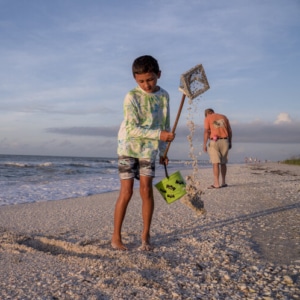
If you’re serious about the pursuit and all about shells on Sanibel Island, you need the right equipment.
STEP 1: The Right Tools
Arm yourself with sunblock, a hat, a shelling sifter or scoop, a bucket, a mesh bag, or net bag, and a strong back. The activity is addicting and you may find yourself doing the “Sanibel Stoop” for hours.
Also, a pair of water shoes may be a good suggestion as some beaches are covered with tiny, sharp shells.
STEP 2: Where To Look
Look for banks of perfect shells as you walk along Sanibel’s beaches. Hundreds of beautiful, tiny shells can be found in these areas. On the shore’s edge and even in the water there are hidden treasures!
STEP 3: When To Start
The best time for shelling is always during low tide, go to the edge of the water where the waves stir up the sand as it hits the beach. Dig down into the sand as well. Dip your net in and see what you find.
STEP 4: Bonus Tip
For a different color scheme, you may want to look higher up on the beach for shells that have been bleached by the sun. These often white-washed specimens can make an unusual collection.
When Should I Look For Shells?
BEST TIME
Early morning low tide is the best time for shelling on Sanibel Island!
While gorgeous shells can be found any time of day, you will have less competition early in the morning, especially an hour before or after low tide. Less competition will leave the best finds for you!
Some shellers say a full moon phase brings in more shells due to higher tides. After a storm is also a great time to look for shells, as they often get swept in by waves.
In the winter months with a north wind–although it can be chilly–is another time that may bring in more little surprises.
BEST SEASON
You can enjoy shelling on Sanibel Island all year long!
The tourist season from January through April is the busiest on beaches and has the best weather. You may have less competition finding shells in the off-season.
Shells also get stirred up during a storm, so during hurricane season or summer months, after a big tropical storm can also be a good time to go shell-hunting.
The annual Sanibel Shell Festival is the longest-running and largest shell show in the world. The festival takes place in early March so it is best for shell lovers to coordinate a trip with attending the event. It is well worth the planning to enjoy this Sanibel shelling event!
Where To Stay On Sanibel Island

In order to get the full shelling experience on Sanibel Island why not stay!
Sanibel & Captiva Island are not short of accommodations with a wide variety of locations and options for any itinerary!
With so many ways to enjoy the island’s beauty, there is something for everyone!
Choose from a resort, vacation rental, waterfront accommodation, or even a Campsite/RV Park.
Whichever way you choose to stay you can guarantee that the best shelling spot won’t be far!
Getting to stay on the Island is such a wonderful way to escape from reality and live your life in paradise. Planning a stay will give you plenty of time to explore all the wonders of this secret oasis.
Is “Live Shelling” Prohibited On All Sanibel Island Beaches?
In the late 1980s, worried about the shell population, Sanibel Island petitioned the Florida Marine Fisheries Commission to restrict live shelling.
As a result, the commission passed a special “Sanibel Shelling” rule called the 46-26. This rule restricted live shell collection to two specimens of any one species per day.
The 46-26 rule was in effect for six years however, enforcement was virtually impossible, and collecting in excess of these limits occurred regularly.
So in 1993 Sanibel Island further petitioned the Fisheries Commission to establish a complete ban on live shelling.
This rule included shellfish, sand dollars, starfish, and sea urchins. After a public hearing, the rule was approved and went into effect on January 1, 1995.
Thanks to the conservation-minded islanders, who pushed for rule 46-26 we now have beaches with an abundance of shells and sea life just waiting for you.
Keep in mind, that there is no collecting of live shells permitted. Under no circumstances can you keep a live seashell, also don’t take too many shells in general.
Over-shelling can harm the environment. Also, make sure to hang on to any plastic bags you may have brought to hold your new collection. Plastic bags are deadly to sea life.
The Florida & Sanibel Island Sea Shelling Law
The state of Florida and Sanibel Island shelling laws prohibit the collection of any live species within a half-mile of the shore, including urchins, sand dollars and sea stars, pursuant to Florida Department of Environmental Protection Rule 46-26.
Violators can face a $500 fine or up to 60 days in jail for a first offense.
Shelling of any kind is also prohibited at J.N. “Ding” Darling National Wildlife Refuge.
For more information on the Florida Shelling Law, Click Here
Getting to Sanibel and Captiva Islands
When planning your fun-filled day of shelling at Sanibel Island it is essential to keep in mind the tolls!
Traveling to Sanibel Island requires a toll fee in order to cross the Sanibel Causeway Bridge.
If you HAVE a physical transponder in your car it is $6.00 to come to the island and it is free (no toll) to leave
If you DO NOT have a physical transponder in your car it is $9.00 to come to the island and it is free (no toll) to leave.
